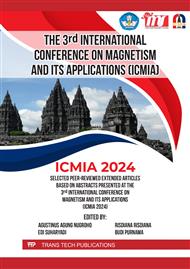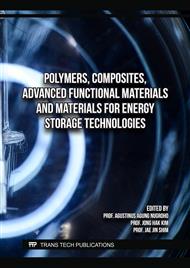[1]
A. K. Geim and K. S. Novoselov, "The rise of graphene," Nanosci. Technol., vol. 6, 2009.
Google Scholar
[2]
V. Iasha, E. Wahyudiana, M. S. Sumantri, A. Marini, B. Setiawan, and D. Rahmawati, "Reduced graphene oxide-based Transparent Conductive Films: The preliminary review of reductant materials agent," IOP Conf. Ser. Mater. Sci. Eng., vol. 1098, no. 6, p.062065, Mar. 2021.
DOI: 10.1088/1757-899X/1098/6/062065
Google Scholar
[3]
A. A. Balandin et al., "Superior Thermal Conductivity of Single-Layer Graphene," Nano Lett., vol. 8, no. 3, p.902–907, Mar. 2008.
DOI: 10.1021/nl0731872
Google Scholar
[4]
Q. Yu et al., "Research on Preparation Process of Graphene by Modified Ball Milling and Its Thermal Properties," IOP Conf. Ser. Mater. Sci. Eng., vol. 735, no. 1, p.012011, Jan. 2020.
DOI: 10.1088/1757-899X/735/1/012011
Google Scholar
[5]
S. Pezzini et al., "High-quality electrical transport using scalable CVD graphene," 2D Mater., vol. 7, no. 4, p.041003, Oct. 2020.
DOI: 10.1088/2053-1583/aba645
Google Scholar
[6]
S. Nigar, Z. Zhou, H. Wang, and M. Imtiaz, "Modulating the electronic and magnetic properties of graphene," RSC Adv., vol. 7, no. 81, p.51546–51580, 2017.
DOI: 10.1039/C7RA08917A
Google Scholar
[7]
G. Ulian and G. Valdrè, "Facile band gap tuning in graphene–brucite heterojunctions," Sci. Rep., vol. 13, no. 1, p.23090, Dec. 2023.
DOI: 10.1038/s41598-023-50037-z
Google Scholar
[8]
X. Yu, H. Cheng, M. Zhang, Y. Zhao, L. Qu, and G. Shi, "Graphene-based smart materials," Nat. Rev. Mater., vol. 2, no. 9, p.17046, Aug. 2017.
DOI: 10.1038/natrevmats.2017.46
Google Scholar
[9]
S. M. Jebreiil Khadem, Y. Abdi, S. Darbari, and F. Ostovari, "Investigating the effect of gas absorption on the electromechanical and electrochemical behavior of graphene/ZnO structure, suitable for highly selective and sensitive gas sensors," Curr. Appl. Phys., vol. 14, no. 11, p.1498–1503, Nov. 2014.
DOI: 10.1016/j.cap.2014.07.020
Google Scholar
[10]
G. Lu, K. Yu, Z. Wen, and J. Chen, "Semiconducting graphene: converting graphene from semimetal to semiconductor," Nanoscale, vol. 5, no. 4, p.1353, 2013.
DOI: 10.1039/c2nr32453a
Google Scholar
[11]
X.-G. Gao, L.-X. Cheng, W.-S. Jiang, X.-K. Li, and F. Xing, "Graphene and its Derivatives-Based Optical Sensors," Front. Chem., vol. 9, p.615164, Feb. 2021.
DOI: 10.3389/fchem.2021.615164
Google Scholar
[12]
A. G. Olabi, M. A. Abdelkareem, T. Wilberforce, and E. T. Sayed, "Application of graphene in energy storage device – A review," Renew. Sustain. Energy Rev., vol. 135, p.110026, Jan. 2021.
DOI: 10.1016/j.rser.2020.110026
Google Scholar
[13]
A. J. W. T. Nenohai, F. M. Santana, R. Asih, R. Arifin, and Darminto, "Effect of N doping on Electronic Band Structure and Magnetic Moments in Graphene Sheets: Density Functional Theory Study," J. Phys. Conf. Ser., vol. 2780, no. 1, p.012009, Jun. 2024.
DOI: 10.1088/1742-6596/2780/1/012009
Google Scholar
[14]
D. Darminto et al., "Unrevealing tunable resonant excitons and correlated plasmons and their coupling in new amorphous carbon-like for highly efficient photovoltaic devices," Sci. Rep., vol. 13, no. 1, p.7262, May 2023.
DOI: 10.1038/s41598-023-31552-5
Google Scholar
[15]
M. Polini, A. Tomadin, R. Asgari, and A. H. MacDonald, "Density functional theory of graphene sheets," Phys. Rev. B, vol. 78, no. 11, p.115426, Sep. 2008.
DOI: 10.1103/PhysRevB.78.115426
Google Scholar
[16]
P. Giannozzi et al., "Quantum ESPRESSO toward the exascale," J. Chem. Phys., vol. 152, no. 15, p.154105, Apr. 2020.
DOI: 10.1063/5.0005082
Google Scholar
[17]
P. Giannozzi et al., "QUANTUM ESPRESSO: a modular and open-source software project for quantum simulations of materials," J. Phys. Condens. Matter, vol. 21, no. 39, p.395502, Sep. 2009.
DOI: 10.1088/0953-8984/21/39/395502
Google Scholar
[18]
K. S. Novoselov et al., "Two-dimensional gas of massless Dirac fermions in graphene," Nature, vol. 438, no. 7065, p.197–200, Nov. 2005.
DOI: 10.1038/nature04233
Google Scholar
[19]
L. O. Yusran, R. Asih, R. Arifin, and Darminto, "Effect of vacancy defects on electronic band structure and magnetic moment of single-layered graphene: a density functional theory study," J. Phys. Conf. Ser., vol. 1951, no. 1, p.012013, Jun. 2021.
DOI: 10.1088/1742-6596/1951/1/012013
Google Scholar
[20]
E. B. Yutomo, F. A. Noor, and T. Winata, "Effect of the number of nitrogen dopants on the electronic and magnetic properties of graphitic and pyridinic N-doped graphene – a density-functional study," RSC Adv., vol. 11, no. 30, p.18371–18380, 2021.
DOI: 10.1039/D1RA01095F
Google Scholar



